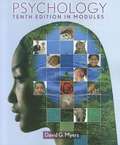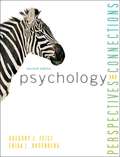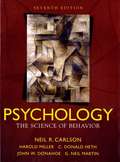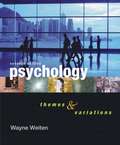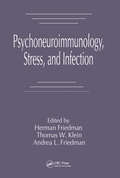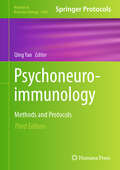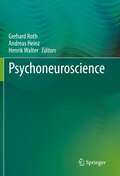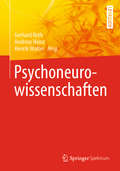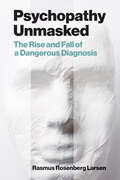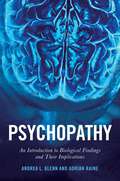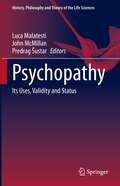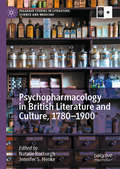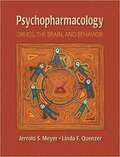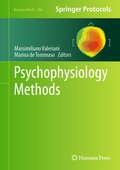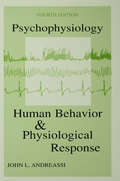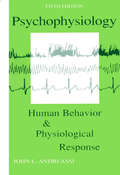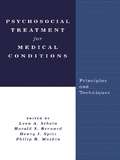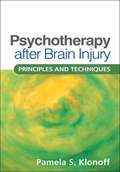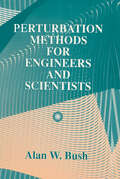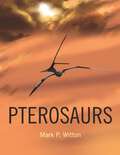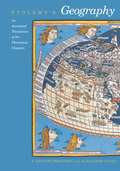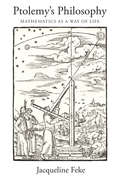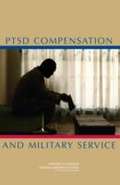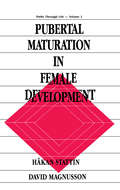- Table View
- List View
Psychology: In Modules (Tenth Edition)
by David G. MyersThis modules-based version of Myers' Psychology tenth edition breaks down the book's 16 chapters into 54 short modules. The condensed text allows students to better grasp and explore psychological concepts. It also makes for more flexibility in teaching, as cross-references to other chapters have been replaced with brief explanations.
Psychology: In Search of the Human Mind (4th Edition)
by Robert J. SternbergSternberg (psychology, Yale University) emphasizes the theme of unity in psychological sciences in this fourth edition. This edition has been edited for readability and interest, and includes new boxed features on how psychologists from different disciplines would treat the same condition. Also new are expanded quizzes, critical thinking questions, and chapter summaries. The CD- ROM contains animations, activities, and videos. Annotation (c)2003 Book News, Inc., Portland, OR (booknews.com)
Psychology: Perspectives and Connections (2nd Edition)
by Gregory Feist Erika RosenbergIn psychology, not everything is black and white. "Psychology: Perspectives & Connections 2e " dares students to challenge their own assumptions, explore research and to not believe everything they think. The over-riding goal of "Psychology: Perspectives & Connections 2e " is to align what excites us as researchers and perpetual students of psychology with todays introductory psychology student. Feist and Rosenbergs aim is to help students understand that psychology, and much of the world around them, is more fascinating--and likely more intricate and interdependent-- than they think. Its not just black and white. And, with Connect Psychology and its adaptive learning system, students can better understand what they know and master what they dont know. Connect with science. Connect with students. Connect with Feist and Rosenbergs "Psychology 2e. "
Psychology: The Science of Behavior (7th edition)
by Neil R. Carlson Harold Miller C. Donald Heth John W. Donahoe G. Neil MartinThis, a rigorous biological and evolutionary approach to introductory psychology text, presents psychological behavior in the context of its adaptive significance. The Seventh Edition combines a scholarly survey of research with real-world applications of research results to problems that confront us today. The authors apply the discovery method to take students inside the research process to foster a critical understanding of the logic and significance of empirical findings.
Psychology: Themes and Variations
by Wayne WeitenA more concise version of the introductory psychology text offering thorough coverage of the major theories (and controversies) in the field today. The focus is on ideas rather than facts, integrating research and application in the areas of biological behavior concepts, sensation and perception, consciousness, conditioning, memory, language and thought, intelligence and psychological testing, emotion, human development, personality theory, stress, psychological disorders, psychotherapy, and social behavior. Includes very jazzy color photographs and illustrations. Paper edition (unseen), $48.75. Annotation c. by Book News, Inc., Portland, Or.
Psychoneuroimmunology, Stress, and Infection
by Herman Friedman Thomas W. Klein Andrea L. FriedmanPsychoneuroimmunology is the emerging science devoted to studying the two-way relationship between the nervous and immune systems. Psychoneuroimmunology, Stress, and Infection highlights the latest information concerning microbial infections in both man and animals as related to stress and especially stress hormones.The volume focuses on psychoneuroimmunology as it impacts the immune system in general and also the relationship between neurological events which influence susceptibility and/or resistance to infectious agents such as bacteria, fungi and viruses, as well as parasites. Prominent researchers describe the involvement of the hypothalamus-pituitary-adrenal (HPA) axis on immunity as a function of the nervous system. The text discusses hormones such as prolactin and growth hormone and steroid induced susceptibility to infection and neuropeptides, including vasoactive intestinal peptide, and substance P. The effects of catacholamines on immunity and susceptibility to infection are also covered. This reference also details the involvement of immune cells in the synthesis of neuropeptides, including hormones and endorphins, their effect on the brain as well as the effects of interleukins and tumor necrosis factor on the central nervous system. The book concludes with an interesting look at the relationship between aging, psychoneuroimmunology, and infection. Although there is much new knowledge concerning the nature and mechanism of immune responses, including the mediators involved, Psychoneuroimmunology, Stress, and Infection also presents important discussions and reviews that are long overdue and provide a major contribution to the area of biomedical knowledge in general and psychoneuroimmunology in particular.
Psychoneuroimmunology: Methods and Protocols (Methods in Molecular Biology #2868)
by Qing YanThis fully-updated third edition provides systems-based methodologies and innovative technologies that can be used for solving complicated problems of complex systems. A wide range of theoretical and experimental approaches are introduced for practical applications, as the content explores the basic and novel concepts in psychoneuroimmunology (PNI), especially the relationships among stress, inflammation, and psychophysiological disorders, as well as various cutting-edge technologies and methods for PNI studies, including the utilizations of mouse models and vaccine models. As part of the Methods in Molecular Biology series, the chapters seek to provide a practical, state-of-the-art, and holistic view for the translation of PNI into better preventive and personalized medical practice. Authoritative and hands-on, Psychoneuroimmunology: Methods and Protocols, Third Edition will be of use to biomedical students and professionals at all levels.
Psychoneuroscience
by Martin LayThe textbook builds a bridge between the "neurosciences" (theoretical and experimental neurobiology, neurology) and the "psychosciences" (psychology, psychiatry, psychotherapy) and aims to help provide the other disciplines with the most important and scientifically validated knowledge in an understandable form. The question of how mental experience and brain processes relate to each other has long been considered mysterious. In this book you will learn, based on the latest scientific findings, that the two areas form an indissoluble unity, even if we experience and study them differently. We present this unity in concrete terms in psychological-neurobiological theory and psychiatric-psychotherapeutic practice. We treat the principles of neurobiological excitation and information processing, the structure and function of the limbic system, the development of the personality and the interaction of genetic-epigenetic factors and prenatal and postnatal environmental influences, which may be favourable or unfavourable. On this basis, the exemplary presentation of important mental disorders such as addictive disorders, schizophrenic disorders, affective disorders and anxiety disorders takes place. Finally, following in the footsteps of the eminent psychotherapist Klaus Grawe, the concept of "neuropsychotherapy" is introduced and it is shown why psychotherapy and neurobiology belong together and can enrich each other. Our psychoneuroscientific approach paints a picture of man that is not based on opposites, but on an integration of psyche, brain, behavior and experience.
Psychoneurowissenschaften
by Martin LayDas Lehrbuch schlägt eine Brücke zwischen den „Neurowissenschaften“ (theoretische und experimentelle Neurobiologie, Neurologie) und den „Psychowissenschaften“ (Psychologie, Psychiatrie, Psychotherapie) und will dabei helfen, den jeweils anderen Disziplinen die wichtigsten und wissenschaftlich gesicherten Kenntnisse in verständlicher Form zu liefern. Die Frage, wie sich psychisches Erleben und Gehirnvorgänge zueinander verhalten, galt lange als rätselhaft. In diesem Buch erfahren Sie aufgrund neuester wissenschaftlicher Erkenntnisse, dass beide Bereiche eine unauflösliche Einheit bilden, auch wenn wir sie unterschiedlich erfahren und untersuchen. Diese Einheit stellen wir in der psychologisch-neurobiologischen Theorie und der psychiatrisch-psychotherapeutischen Praxis konkret dar. Wir behandeln die Prinzipien der neurobiologischen Erregungs- und Informationsverarbeitung, Aufbau und Funktion des limbischen Systems, die Entwicklung der Persönlichkeit und der dabei stattfindenden günstig oder ungünstig verlaufenden Interaktion genetisch-epigenetischer Faktoren und vorgeburtlich sowie nachgeburtlich stattfindender Umwelteinflüssen. Auf dieser Grundlage erfolgt die beispielhafte Darstellung wichtiger psychischer Störungen wie Suchterkrankungen, schizophrene Störungen, affektive Störungen sowie Angststörungen. In der Nachfolge des bedeutenden Psychotherapeuten Klaus Grawe wird schließlich in das, Konzept der „Neuropsychotherapie“ eingeführt und gezeigt, warum Psychotherapie und Neurobiologie zusammengehören, und sich gegenseitig bereichern können. Unser psychoneurowissenschaftlicher Ansatz zeichnet ein Menschenbild, das nicht auf Gegensätzen, sondern einer Integration von Psyche, Gehirn, Verhalten und Erleben beruht.
Psychopathy Unmasked: The Rise and Fall of a Dangerous Diagnosis
by Rasmus Rosenberg LarsenWhy our fascination with psychopaths is scientifically wrongheaded, and how the criminal justice system has misused the controversial science of psychopathy.Psychopathy is a widely acknowledged personality disorder associated with callous unemotional traits and antisocial behaviors. Psychopathic persons are described as dangerous predators incapable of empathy and moral intuition, and while they are believed to make up only around 1 percent of the general population, forensic experts claim they are disproportionately responsible for the majority of violent crimes. Today, psychopathy assessments are being widely used in the legal system to inform a variety of judicial decisions. In Psychopathy Unmasked, Rasmus Rosenberg Larsen provides a critical rebuttal of psychopathy and its legal use, scrutinizing central claims about the diagnosis that have traditionally served to justify its role in the criminal justice system.It is estimated that hundreds of thousands of offenders undergo a psychopathy assessment each year in North America. This book surveys and discusses contemporary developments in psychopathy research where studies have consistently shown that psychopathic persons, contrary to mainstream beliefs, are not meaningfully more dangerous than, or psychologically different from, ordinary non-psychopathic criminals. Based on these disqualifying findings, Larsen argues that we should end the use of psychopathy assessments in the legal system.
Psychopathy: An Introduction to Biological Findings and Their Implications (Psychology and Crime #1)
by Adrian Raine Andrea L GlennWritten in layman&’s terms by accredited scholars, Psychopathy is a concise overview of the neuropsychology of this mental disorder. There has been tremendous growth in biological research on psychopathy, a mental disorder distinguished by traits including a lack of empathy or emotional response, egocentricity, impulsivity, and stimulation seeking. But how does a psychopath&’s brain work? What makes a psychopath? Adrian Raine and Andrea L. Glenn&’s Psychopathy presents a succinct, non-technical summary of the research in the areas of genetics, hormones, brain imaging, neuropsychology, environmental influences, and more, focusing on explaining what is known about the biological foundations for this disorder and offering insights into prediction, intervention, and prevention. It also offers a nuanced discussion of the ethical and legal implications associated with biological research on psychopathy. How much of this disorder is biologically based? Should offenders with psychopathic traits be punished for their crimes if we can show that biological factors contribute? The text clearly assesses the conclusions that can and cannot be drawn from existing biological research, and highlights the pressing considerations this research demands. &“An impressive achievement, covering decades-long research on the neurobiology of antisocial behavior and psychopathy. Frequently authors cannot see the wood for the trees, but the book clearly maps the growing forest that is our understanding of environmental, neurobiological and genetic contributions to psychopathy.&” ―Times Higher Education
Psychopathy: Its Uses, Validity and Status (History, Philosophy and Theory of the Life Sciences #27)
by John McMillan Luca Malatesti Predrag ŠustarThis book explains the ethical and conceptual tensions in the use of psychopathy in different countries, including America, Canada, the UK, Croatia, Australia, and New Zealand. It offers an extensive critical analysis of how psychopathy functions within institutional and social contexts. Inside, readers will find innovative interdisciplinary analysis, written by leading international experts. The chapters explore how different countries have used this diagnosis. A central concern is whether psychopathy is a mental disorder, and this has a bearing upon whether it should be used. The book’s case studies will help readers understand the problems associated with psychopathy. Academics and students working in the philosophy of psychiatry, bioethics, and moral psychology will find it a valuable resource. In addition, it will also appeal to mental health professionals working in forensic settings, psychologists with an interest in the ethical implications of the use of psychopathy as a construct and particularly those with a research interest in it.
Psychopharmacology in British Literature and Culture, 1780–1900 (Palgrave Studies in Literature, Science and Medicine)
by Natalie Roxburgh Jennifer S. HenkeThis collection of essays examines the way psychoactive substances are described and discussed within late eighteenth- and nineteenth-century British literary and cultural texts. Covering several genres, such as novels, poetry, autobiography and non-fiction, individual essays provide insights on eighteenth- and nineteenth-century understandings of drug effects of opium, alcohol and many other plant-based substances. Contributors consider both contemporary and recent medical knowledge in order to contextualise and illuminate understandings of how drugs were utilised as stimulants, as relaxants, for pleasure, as pain relievers and for other purposes. Chapters also examine the novelty of experimentations of drugs in conversation with the way literary texts incorporate them, highlighting the importance of literary and cultural texts for addressing ethical questions.
Psychopharmacology: Drugs, the Brain, and Behaviors (2nd Edition)
by Richard A. Harvey Michelle A. Clark Richard Finkel Jose A. Rey Karen WhalenRecent advances in molecular pharmacology and brain imaging have revolutionized our understanding of how psychoactive drugs work. Now, from the authors of Principles of Neuropsychopharmacology, comes a new undergraduate textbook integrating these developments. The first section of the book provides extensive foundation materials, including the basic principles of pharmacology, neurophysiology and neuroanatomy, synaptic transmission, and methods in psychopharmacology. The second section describes key features of major neurotransmitter systems, including the catecholamines, serotonin, acetylcholine, glutamate and GABA. The third and fourth sections discuss theories and mechanisms of drug addiction and psychopathology. All major substances of abuse as well as drugs used to treat mental illness are covered. Psychopharmacology: Drugs, the Brain and Behavior is unique in its breadth of coverage, ranging from historical accounts of drug use to clinical and preclinical behavioral studies to the latest research on drug effects in transgenic mouse models. Student engagement with the material is fostered by opening each chapter with a relevant vignette and by providing breakout boxes presenting novel or cutting-edge topics for special discussion. The book is extensively illustrated with full-color photographs and line art depicting important concepts and experimental data. Psychopharmacology: Drugs, the Brain and Behavior is appropriate for undergraduate psychopharmacology or drugs and behavior courses that emphasize relationships between the behavioral effects of psychoactive drugs and their mechanisms of action.
Psychophysiology Methods (Neuromethods #206)
by Massimiliano Valeriani Marina De TommasoThis volume looks at the latest advancements used by researchers to study psychophysiology and cognitive neurosciences. The chapters in this book cover topics such as classical event-related brain responses (P300, MMN, and CNV); anatomical structures and physiological mechanisms underlying the capability of feeling pain and smelling; magnetoencephalography (MEG); and brain-computer interface techniques using electrical activity generated by the brain. In the Neuromethods series style, chapters include the kind of detail and key advice from the specialists needed to get successful results in your laboratory. Cutting-edge and practical, Psychophysiology Methods is a valuable resource for researchers who want to learn more about the use of psychophysiological techniques in the investigation of human cognition, and increase interest in the clinical puzzle of neurological and psychiatric disorders.
Psychophysiology: Human Behavior & Physiological Response
by John L. AndreassiThis highly readable and comprehensive overview of psychophysiology provides information regarding the anatomy and physiology of various body systems, methods of recording their activity, and ways in which these measures relate to human behavior. Biofeedback applications are contained in a separate chapter and discussions of stress management, job strain, and personality factors that affect cardiovascular reactivity are presented. There is much of interest here to the student, researcher, and clinician in behavioral medicine, ergonomics, emotion, cognitive neuroscience, neuropsychology, and health psychology. Now in its fourth edition, Andreassi's Psychophysiology explores some of the newer areas of importance and updates findings in traditional topics of interest. Significant changes to this edition include: updated information on brain activity in memory, perception, and intelligence; new information on brain imaging and behavior; separate chapters on pupillography and eye movements; new information on the startle pattern and eyeblink; separate chapters on clinical and non-clinical applications; updated information on cardiovascular reactivity and personality; the latest biofeedback and ergonomics applications; novel findings in environmental psychophysiology; brief summaries at the end of each section; and an appendix on laboratory safety Each chapter is a self-contained unit allowing instructors to customize the presentation of the material. With over 1,700 citations, Andreassi's Psychophysiology is the definitive text in the field. An instructor's manual is now available. Based on the book, the manual is primarily a test bank to be used in giving examinations to students during the teaching of a course. Both multiple-choice and essay questions have been provided, along with lists of key terms and ideas. These can be used for definition-type questions and to highlight important concepts, as well as alerting the instructor to important terms and ideas that they may want to cover in lectures. Sample syllabi are provided for teaching a course at both undergraduate and graduate levels to help the instructor who is preparing a course for the first time. A number of possible laboratory exercises are also provided that can be carried out in conjunction with teaching the course.
Psychophysiology: Human Behavior and Physiological Response
by John L. AndreassiAs new technology fuels the rapid growth of research in psychophysiology, it is essential that those new to the field receive a comprehensive introduction. Psychophysiology: Human Behavior and Physiological Response provides students with elementary information regarding the anatomy and physiology of various body systems, recording techniques, integrative reviews of literature, and concepts in the field. Highly accessible, this book fills a gap between edited handbooks that are often difficult for beginners, and journal articles that may also be a challenge to digest. In this new edition, John L. Andreassi incorporates:*a glossary of terms at the end of each chapter to help students learn definitions of novel terms introduced throughout the book;*a new chapter focusing on the proliferation of neuroimaging studies, including positron emission tomography (PET) and functional magnetic resonance imaging (fMRI); and*content changes in all chapters to cover new areas of research, as well as to update findings in traditional topics of interest. Upper level undergraduate and beginning graduate students in psychophysiology, biological psychology, cognitive neuroscience, and physiological psychology will benefit immensely from this important text, just as professionals new to psychophysiology will find this book exceptionally useful in their work.
Psychosocial Treatment for Medical Conditions: Principles and Techniques
by Philip R. Muskin Leon A. Schein Harold S. Bernard Henry I. SpitzMental Health and Physical Health are undeniably connected. One cannot recover physically, if there is still mental suffering, and vice versa. The essays collected here examine the relationship between mental and physical health, and how that relationship flourishes or suffers in a managed care environment. Understanding more about how the psychological aftereffects of an illness, and the best ways to respond to them, will ultimately enhance the care offered to patients. The contributors offer a wide range of examples of linked physical and mental illnesses, with advice on how best to responsibly address and treat both.Clinicians and practitioners will welcome this guide to navigating a managed care system and working with patients to heal both their mental and physical maladies equally.
Psychotherapy after Brain Injury
by Pamela KlonoffThis book presents hands-on tools for addressing the multiple ways that brain injury can affect psychological functioning and well-being. The author is a leader in the field who translates her extensive clinical experience into clear-cut yet flexible guidelines that therapists can adapt for different challenges and settings. With a focus on facilitating awareness, coping, competence, adjustment, and community reintegration, the book features helpful case examples and reproducible handouts and forms. It shows how to weave together individual psychotherapy, cognitive retraining, group and family work, psychoeducation, and life skills training, and how to build and maintain a collaborative therapeutic relationship.
Psychotropic Bacteria in FoodsDisease and Spoilage
by Allen A. KraftPsychrotrophic Bacteria in Foods: Disease and Spoilage presents a comprehensive review of psychrotrophic bacteria and other pathogens and their role in causing food spoilage in refrigerated and frozen foods. The book focuses on the growth, survival, and subsequent activity of these organisms, especially in meat and poultry products. Metabolic produ
Pterosaurs: Natural History, Evolution, Anatomy
by Mark P. WittonThe most authoritative illustrated book on flying reptiles availableFor 150 million years, the skies didn't belong to birds—they belonged to the pterosaurs. These flying reptiles, which include the pterodactyls, shared the world with the nonavian dinosaurs until their extinction 65 million years ago. Some pterosaurs, such as the giant azhdarchids, were the largest flying animals of all time, with wingspans exceeding thirty feet and standing heights comparable to modern giraffes. This richly illustrated book takes an unprecedented look at these astonishing creatures, presenting the latest findings on their anatomy, ecology, and extinction.Pterosaurs features some 200 stunning illustrations, including original paintings by Mark Witton and photos of rarely seen fossils. After decades of mystery, paleontologists have finally begun to understand how pterosaurs are related to other reptiles, how they functioned as living animals, and, despite dwarfing all other flying animals, how they managed to become airborne. Here you can explore the fossil evidence of pterosaur behavior and ecology, learn about the skeletal and soft-tissue anatomy of pterosaurs, and consider the newest theories about their cryptic origins. This one-of-a-kind book covers the discovery history, paleobiogeography, anatomy, and behaviors of more than 130 species of pterosaur, and also discusses their demise at the end of the Mesozoic.The most comprehensive book on pterosaurs ever publishedFeatures some 200 illustrations, including original paintings by the authorCovers every known species and major group of pterosaursDescribes pterosaur anatomy, ecology, behaviors, diversity, and moreEncourages further study with 500 references to primary pterosaur literature
Ptolemy's Geography: An Annotated Translation of the Theoretical Chapters
by PtolemyPtolemy's Geography is the only book on cartography to have survived from the classical period and one of the most influential scientific works of all time. Written in the second century AD, for more than fifteen centuries it was the most detailed topography of Europe and Asia available and the best reference on how to gather data and draw maps. Ptolemy championed the use of astronomical observation and applied mathematics in determining geographical locations. But more importantly, he introduced the practice of writing down coordinates of latitude and longitude for every feature drawn on a world map, so that someone else possessing only the text of the Geography could reproduce Ptolemy's map at any time, in whole or in part, at any scale. Here Berggren and Jones render an exemplary translation of the Geography and provide a thorough introduction, which treats the historical and technical background of Ptolemy's work, the contents of the Geography, and the later history of the work.
Ptolemy's Philosophy: Mathematics as a Way of Life
by Jacqueline FekeThe Greco-Roman mathematician Claudius Ptolemy is one of the most significant figures in the history of science. He is remembered today for his astronomy, but his philosophy is almost entirely lost to history. This groundbreaking book is the first to reconstruct Ptolemy’s general philosophical system—including his metaphysics, epistemology, and ethics—and to explore its relationship to astronomy, harmonics, element theory, astrology, cosmology, psychology, and theology.In this stimulating intellectual history, Jacqueline Feke uncovers references to a complex and sophisticated philosophical agenda scattered among Ptolemy’s technical studies in the physical and mathematical sciences. She shows how he developed a philosophy that was radical and even subversive, appropriating ideas and turning them against the very philosophers from whom he drew influence. Feke reveals how Ptolemy’s unique system is at once a critique of prevailing philosophical trends and a conception of the world in which mathematics reigns supreme.A compelling work of scholarship, Ptolemy’s Philosophy demonstrates how Ptolemy situated mathematics at the very foundation of all philosophy—theoretical and practical—and advanced the mathematical way of life as the true path to human perfection.
Ptsd Compensation And Military Service
by Institute of Medicine National Research Council of the National AcademiesThe scars of war take many forms: the limb lost, the illness brought on by a battlefield exposure, and, for some, the psychological toll of encountering an extremely traumatic event. PTSD Compensation and Military Service presents a thorough assessment of how the U.S. Department of Veterans Affairs evaluates veterans with possible posttraumatic stress disorder and determines the level of disability support to which they are entitled. The book presents a history of mental health disability compensation of military personnel and reviews the current compensation and pension examination procedure and disability determination methodology. It offers a number of recommendations for changes that would improve the fairness, consistency, and scientific foundation of this vital program. This book will be of interest and importance to policy makers, veterans affairs groups, the armed forces, health care organizations, and veterans themselves.
Pubertal Maturation in Female Development (Paths Through Life Ser.)
by David Magnusson H†kan Stattin Hakan StattinResearch on physical maturity has demonstrated conclusively that the assumption of an age-homogenous development does not always hold true. This volume presents a biosocial model focusing on the role of individual differences in biological maturation to be used as a framework for empirical studies exploring adolescent female development. The longitudinal design of the research program offers the possibilities to examine both short- and long-term consequences for individual variations in pubertal development. In the present volume, the data for these analyses consist of a broad range of biological, mental, psychological, behavioral, and social factors extending from the age of 10 to the age of 30. Some of the questions the present volume attempts to answer are: * Are variations in the timing of pubertal development among girls related to their psychological and social life situation in the adolescent years? If so, when is the relation most prominent? In what areas is the relation most prominent? How does the relation come about? * Do interindividual differences in physical maturation have any long-term consequences for adult life? If so, in what areas, for which girls, and through which developmental processes does pubertal development operate? The long-term consequences are a major concern addressed in considerable detail.
